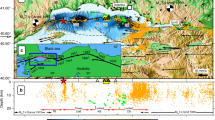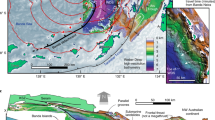Abstract
One of the greatest hazards associated with oceanic volcanoes is not volcanic in nature, but lies with the potential for catastrophic flank failure1,2. Such flank failure can result in devastating tsunamis and threaten not only the immediate vicinity, but coastal cities along the entire rim of an ocean basin3. Kilauea volcano on the island of Hawaii, USA, is a potential source of such flank failures3,4 and has therefore been monitored by a network of continuously recording geodetic instruments, including global positioning system (GPS) receivers, tilt meters and strain meters. Here we report that, in early November 2000, this network recorded transient southeastward displacements, which we interpret as an episode of aseismic fault slip. The duration of the event was about 36 hours, it had an equivalent moment magnitude of 5.7 and a maximum slip velocity of about 6 cm per day. Inversion of the GPS data reveals a shallow-dipping thrust fault at a depth of 4.5 km that we interpret as the down-dip extension of the Hilina Pali–Holei Pali normal fault system. This demonstrates that continuously recording geodetic networks can detect accelerating slip, potentially leading to warnings of volcanic flank collapse.
This is a preview of subscription content, access via your institution
Access options
Subscribe to this journal
Receive 51 print issues and online access
$199.00 per year
only $3.90 per issue
Buy this article
- Purchase on Springer Link
- Instant access to full article PDF
Prices may be subject to local taxes which are calculated during checkout




Similar content being viewed by others
References
McGuire, W. J. in Volcano Instability on the Earth and Other Planets (eds McGuire, W. J., Jones, A. P. & Neuberg, J.) 1–23 (Geological Society Spec. Publ. No. 110, London, 1996).
Moore, J. G. et al. Prodigious submarine landslides on the Hawaiian Ridge. J. Geophys. Res. 94, 17465–17484 (1989).
Ward, S. Landslide tsunami. J. Geophys. Res. 106, 11201–11216 (2001).
Lipman, P. W., Normark, W. R., Moore, J. G., Wilson, J. B. & Gutmacher, C. E. The giant submarine Alika debris slide, Mauna Loa, Hawaii. J. Geophys. Res. 94, 4279–4299 (1988).
Cervelli, P., Murray, M. H., Segall, P., Aoki, Y. & Kato, T. Estimating source parameters from deformation data, with an application to the March 1997 earthquake swarm off the Izu Peninsula, Japan. J. Geophys. Res. 106, 11217–11238 (2001).
Efron, B. & Tibshirani, R. J. An Introduction to the Bootstrap (Chapman and Hall, New York, 1993).
Linde, A. T., Gladwin, M. T., Johnston, M. J. S., Gwyther, R. L. & Bilham, R. G. A slow earthquake sequence on the San Andreas fault. Nature 383, 65–68 (1996).
Dragert, H., Wang, K. & James, T. S. A silent slip event on the deeper Cascadia subduction interface. Science 292, 1525–1528 (2001).
Nakamura, K. Why do long rift zones develop in Hawaiian volcanoes—A possible role of thick oceanic sediments. Bull. Volcanol. Soc. Jpn 25, 255–267 (1980) (in Japanese).
Dieterich, J. H. Growth and persistence of Hawaiian rift zones. J. Geophys. Res. 93, 4258–4270 (1988).
Thurber, C. H. & Gripp, A. E. Flexure and seismicity beneath the south flank of Kilauea Volcano and tectonic implications. J. Geophys. Res. 93, 4271–4278 (1988).
Delaney, P. T., Miklius, A., Árnadóttir, T., Okamura, A. T. & Sako, M. K. Motion of Kilauea Volcano during sustained eruption from the Pu'u O'o and Kupaianaha vents, 1983–1991. J. Geophys. Res. 98, 17801–17820 (1993).
Owen, S. et al. Rapid deformation of the south flank of Kilauea Volcano, Hawaii. Science 267, 1328–1332 (1995).
Owen, S. et al. Rapid deformation of Kilauea volcano: GPS measurements between 1990 and 1996. J. Geophys. Res. 105, 18983–18998 (2000).
Du, Y., Segall, P. & Gao, H. Quasi-static dislocations in three dimensional inhomogeneous media. Geophys. Res. Lett. 24, 2347–2350 (1997).
Aki, K. & Richards, P. G. Quantitative Seismology; Theory and Methods (Freeman, San Francisco, 1970).
Ward, S. N. Quasi-static propagator matrices: creep on strike-slip faults. Tectonophysics 120, 83–106 (1985).
Okubo, P. G., Benz, H. M. & Chouet, B. A. Imaging the crustal magma sources beneath Mauna Loa and Kilauea volcanoes, Hawaii. Geology 25, 867–870 (1997).
Morgan, J. K., Moore, G. F., Hills, D. J. & Leslie, S. Overthrusting and sediment accretion along Kilauea's mobile south flank, Hawaii: Evidence for volcanic spreading from marine seismic reflection data. Geology 28, 667–670 (2000).
Elosegui, P., Davis, J., Johansson, J. & Shapiro, I. Detection of transient motions with the Global Positioning System. J. Geophys. Res. 101, 11249–11261 (1996).
Larson, K. et al. Volcano monitoring using kinematic GPS: Filtering strategies. J. Geophys. Res. 106, 19453–19464 (2001).
Stein, R. S. The role of stress transfer in earthquake occurrence. Nature 402, 605–609 (1999).
David, C., Wong, T.-F., Zhu, W. & Zhang, J. Laboratory measurements of compaction-induced permeability change in porous rocks; implications for the generation and maintenance of pore pressure excess in the crust. Pure Appl. Geophys. 143, 425–456 (1994).
Ingebritsen, S. E. & Scholl, M. A. The hydrology of Kilauea Volcano. Geothermics 22, 255–270 (1993).
Swanson, D. A., Duffield, W. A. & Fiske, R. S. Displacement of the south flank of Kilauea Volcano: The result of forceful intrusion of magma into the rift zones. US Geol. Surv. Prof. Pap. 963, 1–30 (1976).
Dvorak, J. J., Klein, F. W. & Swanson, D. A. Relaxation of the south flank after the 7.2-Magnitude Kalapana earthquake, Kilauea volcano, Hawaii. Bull. Seismol. Soc. Am. 84, 133–141 (1994).
Cannon, E. C., Bürgmann, R. & Owen, S. E. Shallow normal faulting and block rotation associated with the 1975 Kalapana earthquake, Kilauea Volcano, Hawaii. Bull. Seismol. Soc. Am. (in the press).
Lichten, S. & Borden, J. Strategies for high-precision Global Positioning System orbit determination. J. Geophys. Res. 92, 12751–12762 (1987).
Hofmann-Wellenhof, B., Lichtenegger, H. & Collins, J. GPS: Theory and Practice (Springer, New York, 1994).
Acknowledgements
We thank M. Bevis for access to the GPS data for the University of Hawaii network, P. Okubo for providing hypocentres, G. Blewitt, R. Bürgmann, J. Davis, R. Iverson, M. Johnston, J. McGuire, J. Murray, D. Swanson and W. Thatcher for comments and discussion, and D. Okita for getting us to and from Kilauea GPS stations safely and efficiently. The National Science Foundation and the US Geological Survey provided funding for this research.
Author information
Authors and Affiliations
Corresponding author
Ethics declarations
Competing interests
The authors declare no competing financial interests.
Rights and permissions
About this article
Cite this article
Cervelli, P., Segall, P., Johnson, K. et al. Sudden aseismic fault slip on the south flank of Kilauea volcano. Nature 415, 1014–1018 (2002). https://doi.org/10.1038/4151014a
Received:
Accepted:
Issue Date:
DOI: https://doi.org/10.1038/4151014a
This article is cited by
-
Failure of load-bearing dyke networks as a trigger for volcanic edifice collapse
Communications Earth & Environment (2023)
-
Continuous estimation of coseismic and early postseismic slip phenomena via the GNSS carrier phase to fault slip approach: a case study of the 2011 Tohoku-Oki sequence
Progress in Earth and Planetary Science (2022)
-
Incremental caldera collapse at Kīlauea Volcano recorded in ground tilt and high-rate GNSS data, with implications for collapse dynamics and the magma system
Bulletin of Volcanology (2022)
-
Extreme rainfall triggered the 2018 rift eruption at Kīlauea Volcano
Nature (2020)
-
Landslide triggers along volcanic rock slopes in eastern Sicily (Italy)
Natural Hazards (2014)
Comments
By submitting a comment you agree to abide by our Terms and Community Guidelines. If you find something abusive or that does not comply with our terms or guidelines please flag it as inappropriate.



